Carp living transport technology
First, the transport of carp broodstock
1, short-distance wet-water transport using the skin of the fish has a certain respiration, can survive in the humid air for a certain period of time this physiological phenomenon, we can carry out anhydrous wet transport, or dry transport. When transporting, wrap the fish body with water or use a method of watering the fish body to maintain a moist environment and avoid the drying caused by massive evaporation of water, so that the fish can survive skin respiration for a certain period of time, so as to achieve the purpose of transportation. This method should be suitable for low temperature and short distance transportation. The author used to be a broached fish, and the temperature is about 20 degrees Celsius. Within half an hour, the survival rate is as high as 90%.
2, long-distance plastic bags oxygen transport Carp ray fins have hard spines, but also on the head, skull cover also has a small thorn. Should not be directly transported in plastic bags, gauze can be used to wrap the squid squid (that is, with a gauze strip from the back of the fishbone sacrum, in accordance with the vertical axis of the fish body winding to the base of the caudal fin), so that does not damage the fish body It does not cause gauze to fall off due to fish swimming. Then into a plastic bag, each bag of 2 to 4 fish, oxygen sealed to transport.
Second, the transport of carp seedlings
(1) Pre-transplant seedlings Breeding of squid has two main aspects to prepare for transportation: control of feeding and drawing exercise.
The fry should not be fed or fed less on the day before transport. The purpose is to keep the fry free of excess feces during transportation and consume too much water in the water due to digestion. To improve the survival rate of transportation.
The purpose of the pull-net exercise is to enhance the juvenile constitution and increase the survival rate during the outing and transportation. Because pulling the net makes the fish frightened, it increases the amount of exercise and makes the muscle strong. At the same time, in the intensive process, the juveniles are encouraged to secrete mucus and excrete feces, increase the adaptability to oxygen resistance, and avoid large amounts of mucus and feces contaminating the water during the transportation process, thereby contributing to the improvement of the survival rate. In addition, pulling the net can also remove wild fish, eliminate aquatic insects, and accurately estimate the number of fish.
(2) Preventing mechanical damage to carp seedlings during transportation The carp is a carp, which is not easy to recover after injury. In particular, the mortality rate after dorsal fin and tail injury is extremely high, so a series of operations during the transport process (fishing, counting , bagging, transportation, and under the net) should strive to be light and reduce the damage of the carp.
(3) Disinfection of squid before stocking Squid will suffer more or less damage after long-distance transportation, and the fish body will be susceptible to secondary watery mildew after injury. Therefore, all squid should be disinfected before stocking, and the available concentration 2 3% to 3% saline immersion for 3 to 5 minutes can effectively prevent the secondary infection of carp.
Third, special methods of operation
1. The anesthetic transport method transports squid on a certain concentration of anesthetic solution to make the fish in a coma during transportation. At this time, the degree of metabolism and oxygen consumption of the fish are reduced, which is favorable for transportation.
(1) Kulenadine (1/200,000 concentration), Ulaitan (1/1000-4/1000 concentration) can both be anesthetized to transport broodstock.
(2) Ether can also be anesthetized with ether when transported over short distances. First use a cotton ball to dip a little ether (about 2.5 kg diethyl ether for a broiler with a body weight of 15 kg) and stuff it into the mouth of the fish. After 2-3 minutes of brooding, put it in a container filled with water and transport it. hour.
2. Cooling transportation method The cooling treatment of squid before transportation means that the squid is first placed in the water above 10 degrees Celsius (water cooling with ice) to slowly cool down, then moved to a temperature of about 6 degrees Celsius to slow down the temperature, and then packed and transported. Continue to use the ice to keep the temperature low.
Orchards and Apple products certified by organic agricultural production system, produced and processed according to organic certification standards and certified by independent organic food certification bodies. Apple Certified by the organic food certification organization and issued certificates according to the organic food planting standards and processing technology specifications. In the process of production and processing of apple, the use of synthetic substances such as pesticides, fertilizers, herbicides, synthetic pigments, hormones and other synthetic substances are absolutely prohibited, which conform to the requirements of the ecological system.

Organic Golden Delicious,Fresh Organic Golden Delicious,Organic Red Golden Delicious,Organic Golden Delicious Apples
Ningxia Hongqiaozhigu Technology&Development Co.,Ltd , http://www.guofuhui-ec.com